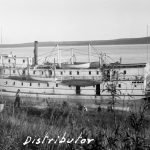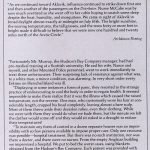1928
Influenza Epidemic
During the summer of 1928, the Hudson’s Bay Company’s supply ship SS Distributor was on its annual trip down the Mackenzie River to distribute the yearly treaty payment. The annual trip to the posts was usually a time to meet family, resupply for the summer camps and alleviate the long winter. The previous winter had been bad for hunting, as the government put in restrictions due to the fragile fur animal stocks. While usually bringing relief, the Distributor spread misery and death as it carried a virulent influenza (flu) strain.
Lacking previous exposure to influenza, the contact with infected passengers quickly became a deadly epidemic killing an estimated 10 to 15% of the Indigenous population of the Northwest Territories. The official police report listed 200 Indigenous and non-Indigenous people who died, but this number was likely confined to RCMP patrol areas and likely vastly underreported. Influenza took a much higher percentage of the people in remote locations, and stories tell of places where no one survived to bury the dead. Philip H. Godsell, the Inspector of the Hudson’s Bay Company, wrote: “Daily the doleful tolling of the mission bells the full length of that vast river proclaimed the passing of another and still another soul. Soon it became impossible to dig graves for all the dead, so they were wrapped in blankets and buried in a common grave.”
In and around the Mackenzie valley and Arctic coast trading posts, the Royal Canadian Mounted Police, the clergy, and Hudson’s Bay Company employees cared for the sick often while ill themselves. Families lost their Elders, hunters, and caregivers, adding to the burden and trauma of the survivors. There were many pleas for more medical assistance as promised in the Treaty negotiations for the Mackenzie District. The horrors of the summer of 1928 would not be forgotten.




